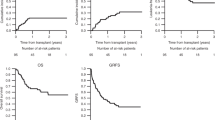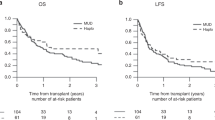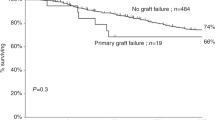Summary:
Philadelphia chromosome (Ph) acute lymphoblastic leukemia-positive (ALL) is a subgroup of ALL with a poor prognosis. We sought to evaluate the results of allogeneic hematopoietic stem cell transplantation (HSCT) in this situation. From 1992 to 2000, 121 patients with Ph- positive ALL enrolled in one of the three main French prospective ALL chemotherapy trials and receiving allogeneic HSCT were reported to the registry of the French Society of Bone Marrow Transplantation (SFGM-TC). The median age was 35 years (range, 1–53). In all, 76 patients received HSCT in first complete remission and 45 in a more advanced disease stage. Minimal residual disease was evaluated just before the graft: 35 patients of the 52 patients in first remission had persistent BCR-ABL transcript detectable while 17 had no detectable minimal residual disease. Bone marrow and/or peripheral blood samples from 94 patients were submitted for reverse transcriptase polymerase chain reaction analysis at variable points after transplantation. Estimated 2-year survival and relapse rate for patients in CR1 were 50 and 37%, respectively, significantly better than for patients with more advanced disease (P=0.0001 and 0.01, respectively). There was no difference in survival or in relapse rates in terms of the donor used. Relapse was the most common cause of treatment failure. Hematological status at the time of transplant and the occurrence of acute graft-versus-host disease (GvHD) were the only two prognostic factors identified for relapse (P=0.02 and 0.02, respectively). Detection of BCR-ABL transcripts after transplantation had a predictive value on relapse occurrence. Finally, donor lymphocyte infusions were successfully used to treat some relapses. The graft-versus-leukemia effect of HSCT in Ph-positive ALL appears to be supported by (1) the lack of prognostic significance of pretransplant BCR-ABL transcript detection, (2) the efficacy of donor lymphocyte infusions in cases of relapse, and (3) the role of GvHD as protecting against relapse.
This is a preview of subscription content, access via your institution
Access options
Subscribe to this journal
Receive 12 print issues and online access
$259.00 per year
only $21.58 per issue
Buy this article
- Purchase on Springer Link
- Instant access to full article PDF
Prices may be subject to local taxes which are calculated during checkout




Similar content being viewed by others
References
Tuszynski A, Dhut S, Young BD et al. Detection and significance of bcr-abl mRNA transcripts and fusion proteins in Philadelphia-positive adult acute lymphoblastic leukemia. Leukemia 1993; 7: 1504–1508.
Faderl S, Kantarjian HM, Talpaz M, Estrov Z . Clinical significance of cytogenetic abnormalities in adult acute lymphoblastic leukemia. Blood 1998; 91: 3995–4019.
Suryanarayan K, Hunger SP, Kohler S et al. Consistent involvement of the bcr gene by 9;22 breakpoints in pediatric acute leukemias. Blood 1991; 77: 324–330.
Maurer J, Janssen JWG, Thiel E et al. Detection of chimeric BCR-ABL genes in acute lymphoblastic leukaemia by the polymerase chain reaction. Lancet 1991; 337: 1055–1058.
Radich J, Gehly G, Lee A et al. Detection of bcr-abl transcripts in Philadelphia chromosome-positive acute lymphoblastic leukemia after marrow transplantation. Blood 1997; 89: 2602–2609.
Bloomfield CD, Wurster-Hill D, Peng G et al. Prognostic significance of the Philadelphia chromosome in adult acute lymphoblastic leukemia. In: Gale RP, Hoelzer D (eds). Acute Lymphoblastic Leukemia. Alan R Liss: New York 1990, pp 101–109.
Groupe Français de Cytogénétique Hématologique. Cytogenetic abnormalities in adult acute lymphoblastic leukemia: correlations with hematologic findings and outcome. A collaborative study of the Groupe Français de Cytogénétique Hématologique. Blood 1996; 87: 3135–3142.
Beyermann B, Adams HP, Henze G . Philadelphia chromosome in relapsed childhood acute lymphoblastic leukemia: a matched-pair analysis. Berlin–Frankfurt–Munster Study Group. J Clin Oncol 1997; 15: 2231–2237.
Arico M, Valsecchi MG, Camitta B et al. Outcome of treatment in children with Philadelphia chromosome-positive acute lymphoblastic leukemia. N Engl J Med 2000; 342: 998–1006.
Snyder DS . Allogeneic stem cell transplantation for Philadelphia chromosome -positive acute lymphoblastic leukemia. Biol Blood Marrow Transplantation 2000; 6: 597–603.
Barrett AJ, Horowitz MM, Ash RC et al. Bone marrow transplantation for Philadelphia chromosome-positive acute lymphoblastic leukemia. Blood 1992; 79: 3067–3070.
Dunlop LC, Powles R, Singhal S et al. Bone marrow transplantation for Philadelphia chromosome-positive acute lymphoblastic leukemia. Bone Marrow Transplant 1996; 3: 365–369.
Chao NJ, Blume KG, Forman SJ et al. Long-term follow-up of allogeneic bone marrow recipients for Philadelphia chromosome-positive acute lymphoblastic leukemia. Blood 1995; 85: 3353–3354.
Thomas X, Thiebaut A, Olteanu N et al. Philadelphia chromosome positive adult acute lymphoblastic leukemia: characteristics, prognostic factors and treatment outcome. Hematol Cell Ther 1998; 40: 119–128.
Marks DI, Bird JM, Cornish JM et al. Unrelated donor bone marrow transplantation for children and adolescents with Philadelphia-positive acute lymphoblastic leukemia. J Clin Oncol 1998; 16: 931–936.
Sierra J, Radich J, Hansen JA et al. Marrow transplants from unrelated donors for treatment of Philadelphia chromosome-positive acute lymphoblastic leukemia. Blood 1997; 90: 1410–1414.
Miyamura K, Tanimoto M, Morishima Y et al. Detection of Philadelphia chromosome positive acute lymphoblastic leukemia by polymerase chain reaction: possible eradication of minimal residual disease by marow transplantation. Blood 1992; 79: 1366–1370.
Preudhomme CN, Henic B, Cazin JL et al. Good correlation between RT-PCR analysis and relapse in Philadelphia-positive acute lymphoblastic leukemia. Leukemia 1997; 11: 294–298.
Michel G, Landman-Parker J, Auclerc MF et al. Use of recombinant human granulocyte colony-stimulating factor to increase chemaotherapy dose-intensity: a randomized trial in very high risk childhood acute lymphoblastic leukemia. J Clin Oncol 2000; 18: 1517–1524.
Ifrah N, Witz F, Jouet JP et al. Intensive short term therapy with granulocyte-macrophage colony-stimulating factor support, similar to therapy for acute myeloblastic leukemia, does not improve overall results for adults with acute lymphoblastic leukemia. GOELAMS Group. Cancer 1999; 86: 496–505.
Dombret H, Gabert J, Boiron JM et al. for the Groupe d'étude et de traitement de la leucémie aiguë lymphoblastique de l' adulte (GET-LAL group). Outcome of treatment in adults with Philadelphia chromosome-positive acute lymphoblastic leukemia: results of the prospective multi-center LALA-94 trial. Blood 2002; 100: 2357–2366.
ISCN (International System for Human Cytogenetic Nomenclature). Guidelines for cancer cytogenetics. In: Mitelman F (ed.). Supplement to an International System for Human Cytogenetic Nomenclature. Karger: Basel, 1991, pp 1–53.
Kawasaki ES, Clark SS, Coyne MY et al. Diagnosis of chronic myeloid and acute lymphocytic leukemias by detection of leukemia-specific mRNA sequences amplified in vitro. Proc Natl Acad Sci USA 1988; 85: 5698–5702.
Raynaud S, Mauvieux L, Cayuela JM et al. TEL-AML1 fusion gene is a rare event in adult acute lymphoblastic leukemia. Leukemia 1996; 10: 1529–1530.
van Dongen JJ, Macintyre EA, Gabert JA et al. Standardized RT-PCR analysis of fusion gene transcripts from chromosome aberrations in acute leukemia for detection of minimal residual disease. Report of the BIOMED-1 concerted action: investigation of minimal residual disease in acute leukemia. Leukemia 1999; 13: 1901–1928 (Review).
Deconinck E, Cahn JY, Milpied N et al. Allogeneic bone marrow transplantation for high-risk acute lymphoblastic leukemia in first remission: long-term results for 42 patients conditioned with an intensified regimen (TBI, high-dose Ara-C and melphalan). Bone Marrow Transplant 1997; 9: 731–735.
Glucksberg H, Storb R, Fefer A et al. Clinical manifestations of graft-versus-host disease in human recipients of marrow from HL-A-matched sibling donors. Transplantation 1974; 4: 295–304.
Przepiorka D, Weisdorf D, Martin P et al. 1994 Consensus conference on acute GVHD grading. Bone Marrow Transplant 1995; 6: 825–828.
Flowers MED, Kansu E, Sullivan KM . Pathophysiology and treatment of graft-versus-host disease. Hematol Oncol Clin North Am 1999; 13: 1091.
Kaplan E, Meier P . Nonparametric estimation from incomplete observations. J Am Stat Assoc 1958; 53: 457–481.
Peto R, Peto J . Asymptotically efficient rank invariant test procedures. J R Stat Soc A 1972; 135: 185–206.
Cox DR . Regression models and life-tables. J R Stat Soc B 1972; 34: 187–220.
Annino L, Ferrari A, Cedrone M et al. Adult Philadelphia-chromosome-positive acute lymphoblastic leukemia: experience of treatments during a ten-year period. Leukemia 1994; 8: 664–667.
Faderl S, Kantarjian HM, Thomas DA et al. Outcome of Philadelphia chromosome-positive adult acute lymphoblastic leukemia. Leukemia Lymphoma 2000; 36: 263–273.
Uckun FM, Nachman JB, Sather HN et al. Clinical significance of Philadelphia chromosome positive pediatric acute lymphoblastic leukemia in the context of contemporary intensive therapies: a report from the Children's Cancer Group. Cancer 1998; 83: 2030–2039.
Snyder DS, Nademanee AP, O'Donnell MR et al. Long-term follow-up of 23 patients with Philadelphia chromosome-positive acute lymphoblastic leukemia treated with allogeneic bone marrow transplant in first complete remission. Leukemia 1999; 13: 2053–2058.
Cornelissen JJ, Carston M, Kollman C et al. Unrelated marrow transplantation for adult patients with poor-risk acute lymphoblastic leukemia: strong graft-versus-leukemia effect and risk factors determining outcome. Blood 2001; 97:1572–1577.
Snyder DS, Negrin RS, Blume KG et al. Allogeneic bone marrow transplantation for BCR-ABL positive acute lymphoblastic leukemia [abstract]. Ann Hematol 1999; 78 (Suppl II): 59.
Kroger N, Kruger W, Wacker-Backhaus G et al. Intensified conditioning regimen in bone marrow transplantation for Philadelphia chromosome-positive acute lymphoblastic leukemia. Bone Marrow Transplant 1998; 22: 1029–1033.
Author information
Authors and Affiliations
Consortia
Appendix
Appendix
The members of the participating teams from the SFGM-TC are: A Baruchel, A Devergie, H Dombret, H Espérou, E Gluckman, Ph Guardiola, T Leblanc, P Ribaud, Ph Rousselot, G Socié (Hôpital Saint-Louis, Paris); JM Boiron, J Reiffers (Hôpital du Haut Lévêque, Pessac); M Kuentz, C Cordonnier, J Beaune (Hôpital Henri Mondor, Créteil); I Yacoub-Agha, JP Jouet (Hôpital Huriez, Lille); E Deconinck, JY Cahn (Hôpital Jean Minjoz, Besançon); Ph Moreau, N Milpied, B Gueglio (Hôtel Dieu, Nantes); JH Bourhis, L Jolibois (Institut Gustave Roussy, Villejuif); M Michalet, V Lhéritier (Hopital Edouard Herriot, Lyon); C Faucher, D Blaise, D Reportier (Institut Paoli Calmette, Marseille); P Bordigoni (Hôpital d'enfants Vandoeuvre lès Nancy); N Ifrah, M Truchan-Graczyk (Centre Hospitalier, Angers); N Dhedin, JP Vernant, L Sutton, M Cornillot (Hôpital de la Pitié-Salpétrière, Paris); M Attal (Hôpital Purpan, Toulouse); B Lioure (Hôpital de Haute Pierre, Strasbourg) N Fegeux, Ph Quittet, JF Rossi (Centre hospitalier, Montpellier); A Buzyn, A Fisher, I Hirsh (Hôpital Necker, Paris); A Stamatoulas-Bastard, H Tilly (Centre Henri Becquerel, Rouen); D Guyotat (Hôpital Nord Saint-Etienne); F Demeocq, JL Stephan, JO Bay (Clermond Ferrand); M Duval, E Vilmer, R Larche (Hôpital Robert Debré, Paris); F Garban, JJ Sotto (Hôpital Michallon, Grenoble); A Sadoun (Hôpital Jean Bernard, Poitiers); N Gratecos (Hôpital de L'Archet, Nice); T de Revel, G Nedellec (Hôpital Inter Armées Percy, Clamart).
Rights and permissions
About this article
Cite this article
Espérou, H., Boiron, JM., Cayuela, JM. et al. A potential graft-versus-leukemia effect after allogeneic hematopoietic stem cell transplantation for patients with Philadelphia chromosome-positive acute lymphoblastic leukemia: results from the French Bone Marrow Transplantation Society. Bone Marrow Transplant 31, 909–918 (2003). https://doi.org/10.1038/sj.bmt.1703951
Received:
Accepted:
Published:
Issue Date:
DOI: https://doi.org/10.1038/sj.bmt.1703951
Keywords
This article is cited by
-
Tyrosine kinase inhibitors in Ph+ acute lymphoblastic leukaemia: facts and perspectives
Annals of Hematology (2016)
-
Allogeneic hematopoietic stem cell transplantation in adult acute lymphoblastic leukemia: potential benefit of medium-dose etoposide conditioning
Experimental Hematology & Oncology (2015)
-
Dual effect of oxidative stress on leukemia cancer induction and treatment
Journal of Experimental & Clinical Cancer Research (2014)
-
Outcome after HSCT in Philadelphia chromosome positive acute lymphoblastic leukemia in Sweden: a population-based study
Medical Oncology (2014)
-
Treatment of Philadelphia Chromosome-Positive Acute Lymphoblastic Leukemia
Current Hematologic Malignancy Reports (2013)



